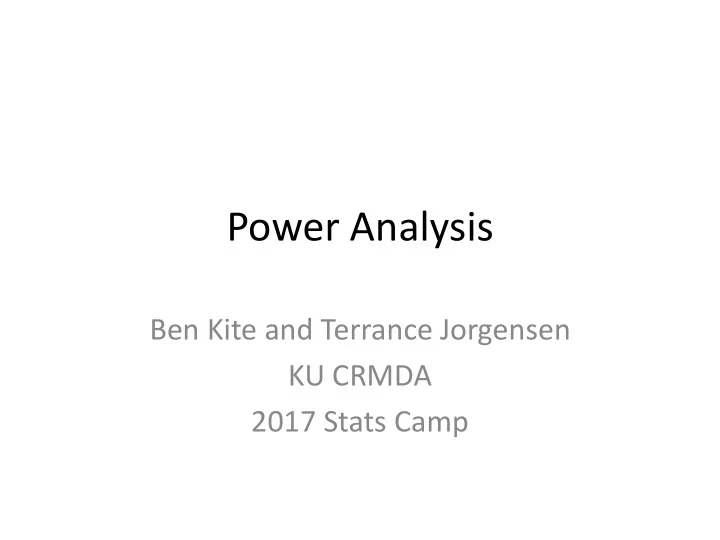

Power Analysis Ben Kite and Terrance Jorgensen KU CRMDA 2017 Stats Camp
Recall Hypothesis Testing? • Null Hypothesis Significance Testing (NHST) is the most common application in social science – Frame research hypothesis as an “alternative” (H 1 ) to a “null” hypothesis (H 0 ) that is given preference – Design study to test H 0 , collect data • Reject H 0 when data are uncommon if H 0 is true • If you fail to reject H 0 , you can’t reject H 0 as a plausible explanation for the observed data
Examples of H 0 • Effect of wealth on electricity demand is β 1 = 7 Electricity Demand = β 1 + β 3 Wealth + ϵ 7 3 = 10 – Estimate from data is β – Is 10 far enough from 7 for H 0 to be rejected? • Gender difference is μ Men − μ Women = μ diff = 0 – Estimate is µ ; <=>> = −5 – Is the observed difference big enough to convince us that H 0 is untenable?
What Is Statistical Power? • The probability of rejecting H 0 , on the condition that it is FALSE (1 – Type II error) – Only makes sense in the context of NHST – Conduct before data collection (avoid post hoc ) • Affected by 4 factors – Rejection criterion (α level) – Sample size ( N ) – Sampling variability ( SD , σ 2 ) – Effect size (the degree to which H 0 is false)
Motivation Behind Power Analyses • Important part of research proposals – How many cases are required to reject your H 0 ? – Funding agencies & dissertation advisors want to make sure they aren’t wasting time & money • Think backwards – Imagine a completed study, with data – MUST write down the actual model to be estimated – With “made up data” of size N , using carefully chosen population parameters, how often is a “significant” effect detected? – If not, how large must N be to detect the effect at least as often as a minimum threshold?
Real-Life Research Example • Researcher collects data on N = 10 people to find out whether tobacco causes cancer – Statistical procedure says there’s no relationship, so we can’t reject H 0 of no relationship – Suppose the effect of tobacco on cancer risk is actually present, but we missed it by not collecting enough data (Type II error) • 80% is a customary threshold for “enough” power – We should design experiments so the power ≥ 0.8 • Measure variables with little variance; collect large N • Effect must be “large” if it is to be detected with small N – If effect is “small,” then we increase N to increase chances of finding a “significant” result (i.e., of rejecting H 0 )
Effect Sizes • Raw effect sizes are just the parameter estimate minus the null hypothesized value 7 − β 1 ) – Regression slopes ( β – Mean-differences between groups ( µ ; @=>> − µ 1 ) – Often can divide difference by SE for a t statistic • Let’s look at the R syntax – Continuing the example from this morning’s workshop on Monte Carlo Simulation • See PowerAnalysis-01.R (or accompanying HTML file)
Effect Sizes • Effect Size = magnitude of difference between a parameter estimate and its H 0 value (e.g., µ ; − µ 1 ) • APA requires “standardized” effect sizes – Seeking a number that is generic across contexts – Supposed to represent “practical” significance, but effects in units of SD or proportions are not always intuitive or useful • Cohen (1988) pioneered the most frequently used criteria for describing effect sizes and estimating power among social scientists – Back to R! (see also G*Power)
Monte Carlo Power Analysis • A Monte Carlo study where: – The outcome of interest is statistical power – The main manipulated factor is N • Useful because analytical methods only cover simple cases – Power = the proportion of samples in a condition for which H 0 was rejected • Can manipulate other factors – Effect size, alpha, variability, missing data, etc.
Free Power Analysis Resources • G*Power ( http://www.gpower.hhu.de/en.html ) – Linear Models (regression, correlation, t test, ANOVA, ANCOVA, MANOVA, MANCOVA) – Some generalized linear models (Poisson or logistic regression) – Contingency tables ( χ 2 , McNemar’s test) – Proportion tests – The user’s manual on the website is easy to read (lot’s of pictures and easy instructions)
Free Power Analysis Resources • WebPower ( http://webpower.psychstat.org/wiki/ ) – Correlation, regression – Proportion/Mean differences – Mediation – Multilevel and Longitudinal modeling – Structural equation modeling – Fairly new, may have bugs
Free Power Analysis Resources • Multilevel Modeling power analysis software – PINT ( http://www.stats.ox.ac.uk/~snijders/multilevel.htm#progPINT ) • Uses analytical approximation, 2-level models only – MLPowSim ( http://www.bristol.ac.uk/cmm/software/mlpowsim/ ) • Makers of MLwiN (among the best MLM software) • You input characteristics of your data (summary stats of predictors, sample size at each level) and population parameters, then MLPowSim writes an R script for Monte Carlo simulation-based power analysis
CRMDA Resources • For SEMs (and more), see KUant Guide #12: Monte Carlo Simulation in M plus – See http://crmda.ku.edu/kuant-guides – This is primarily SEM software (not free), but it can also be used for anything that can be framed as a • Linear model ( t test, ANOVA, regression) • Generalized linear model (Poisson or logistic regression) • Multilevel / mixed-effects model – Just need to know how to write model in M plus syntax
Recommend
More recommend